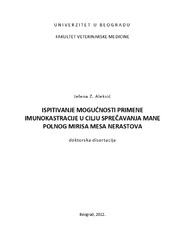Приказ основних података о документу
The investigation into the efficacy of immunocastration aimed at the prevention of sex odour in boar's meat
Ispitivanje mogućnosti primene imunokastracije u cilju sprečavanja mane polnog mirisa mesa nerastova
| dc.contributor.advisor | Baltić, Milan Ž. | |
| dc.contributor.other | Baltić, Milan Ž. | |
| dc.contributor.other | Aleksić, Zoran | |
| dc.contributor.other | Stojić, Velibor | |
| dc.contributor.other | Teodorović, Vlado | |
| dc.creator | Aleksić, Jelena | |
| dc.date.accessioned | 2020-06-03T12:31:56Z | |
| dc.date.available | 2020-06-03T12:31:56Z | |
| dc.date.issued | 2012 | |
| dc.identifier.uri | http://vbs.rs/scripts/cobiss?command=DISPLAY&base=70036&RID=42748175 | |
| dc.identifier.uri | http://nardus.mpn.gov.rs/123456789/2962 | |
| dc.identifier.uri | https://vet-erinar.vet.bg.ac.rs/handle/123456789/17 | |
| dc.description.abstract | Boar taint or meat sex odour, which can be extremely offensive, is frequently present in meat from non-castrated male pigs. This defect is principally caused by sex steroids, primarily androstenone, as well as indole and its derivatives, mainly skatole. Various means have been used to prevent the sex odour in meat, young boar castration being one of the most popular. In Europe surgical castration was most frequently completed without anaesthesia. The procedure is accompanied by pain and stress and conflicts with the principles of animal welfare, which is why it has been abandoned in many countries where animal welfare has been raising growing concern. Thus, it is necessary to produce alternative solutions to prevent this defect in meat. One of the promising alternatives to surgical castration and potential solution to the problem of sex odour in meat, i.e. decline in androstenone and skatole contents in the boar‘s fat, is immunocastration. The main goal of this PhD thesis has been the investigation into the efficacy of immunocastration in the prevention of sex odour in young boar‘s meat. In addition, comparative analyses of carcass muscling and meat quality in castrates, boars and immunocastrated boars have been performed. The acceptability of meat was evaluated by selected trained assessors. The research was conducted on three groups of male animals: surgically castrated pigs (at the age of less than seven days), boars and immunocastrates; each group comprised 30 animals. All pigs were descendents of a single boar (a crossbred of Duroc and Pietrain) and sows of the same line (crossbreds of Landrace and Yorkshire), were kept in identical conditions and fed with the same food. | en |
| dc.description.abstract | Polni miris mesa je ofanzivan i neprijatan miris mesa poreklom od nekastriranih svinja. Pojavi ove mane doprinose polni steroidi, od kojih je androstenon od posebnog značaja, kao i indol i njegovi derivati, meĎu kojima je najpoznatiji skatol. U cilju sprečavanja pojave polnog mirisa mesa do sada su korišćeni različiti postupci, a jedan od najčešće korišćenih postupaka je kastracija nerastova. Najčešća praksa u Evropi u cilju kontrole ove mane mesa je izvoĎenje kastracije bez anestezije. IzvoĎenjem ove intervencije prouzrokuje se bol i stres i narušava dobrobit ţivotinja, što je predstavljalo podsticaj da se u mnogim zemljama, gde je poslednjih godina dobrobit ţivotinja od velikog interesa, odustane od kastracije. Napuštanje ove metode zahteva nalaţenje alternativnih rešenja u cilju otklanjanja ove mane mesa. Jedna od obećavajućih alternativa hirurškoj kastraciji i potencijalno rešenje problema polnog mirisa mesa, odnosno smanjenja sadrţaja androstenona i skatola u masnom tkivu nerastova je imunološka kastracija (imunokastracija). Osnovni cilj istraţivanja u okviru doktorske disertacije bio je ispitivanje mogućnosti primene imunokastracije u cilju sprečavanja mane polnog mirisa mesa nerastova. Istraţivanja su posvećena i uporednoj analizi mesnatosti trupova i kvaliteta mesa kastrata, nerastova i imunokastrata. Jedan od ciljeva odnosi se i na ispitivanje prihvatljivosti mesa od strane izabranih i obučenih ocenjivača. U ogled su bile uključene tri grupe, od po 30 svinja. Grupe su činile hirurški kastrirana grla (do sedmog dana starosti), nerastovi i imunokastrati. Sve grupe svinja poticale su od jednog nerasta (melez duroka i pijetrena) i krmača iste linije (melez landrasa i jorkšira) i drţane su i hranjene na isti način... | sr |
| dc.language | sr | |
| dc.publisher | Univerzitet u Beogradu, Fakultet veterinarske medicine | |
| dc.rights | openAccess | |
| dc.rights.uri | https://creativecommons.org/licenses/by-sa/4.0/ | |
| dc.subject | boar | en |
| dc.subject | meat sex odour | en |
| dc.subject | castration | en |
| dc.subject | immunocastration | en |
| dc.subject | nerastovi | sr |
| dc.subject | polni miris mesa | sr |
| dc.subject | kastracija | sr |
| dc.subject | imunokastracija | sr |
| dc.title | The investigation into the efficacy of immunocastration aimed at the prevention of sex odour in boar's meat | en |
| dc.title | Ispitivanje mogućnosti primene imunokastracije u cilju sprečavanja mane polnog mirisa mesa nerastova | sr |
| dc.type | doctoralThesis | |
| dc.rights.license | BY-SA | |
| dcterms.abstract | Балтић, Милан Ж.; Теодоровић, Владо; Стојић, Велибор; Балтић, Милан Ж.; Aлексић, Зоран; Aлексић, Јелена; Испитивање могућности примене имунокастрације у циљу спречавања мане полног мириса меса нерастова; Испитивање могућности примене имунокастрације у циљу спречавања мане полног мириса меса нерастова; | |
| dc.identifier.fulltext | https://vet-erinar.vet.bg.ac.rs/bitstream/id/659/16.pdf | |
| dc.identifier.rcub | https://hdl.handle.net/21.15107/rcub_nardus_2962 | |
| dc.type.version | publishedVersion |

